Solar eclipse of August 23, 2044
A total solar eclipse will occur on Tuesday, August 23, 2044. A solar eclipse occurs when the Moon passes between Earth and the Sun, thereby totally or partly obscuring the image of the Sun for a viewer on Earth. A total solar eclipse occurs when the Moon's apparent diameter is larger than the Sun's, blocking all direct sunlight, turning day into darkness. Totality occurs in a narrow path across Earth's surface, with the partial solar eclipse visible over a surrounding region thousands of kilometres wide.
| Solar eclipse of August 23, 2044 | |
|---|---|
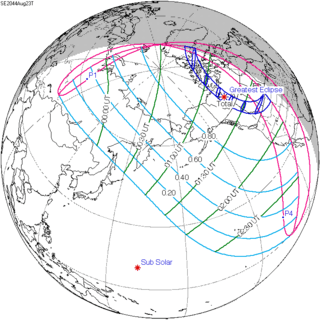 Map | |
| Type of eclipse | |
| Nature | Total |
| Gamma | 0.9613 |
| Magnitude | 1.0364 |
| Maximum eclipse | |
| Duration | 124 sec (2 m 4 s) |
| Coordinates | 64.3°N 120.4°W |
| Max. width of band | 453 km (281 mi) |
| Times (UTC) | |
| Greatest eclipse | 1:17:02 |
| References | |
| Saros | 126 (49 of 72) |
| Catalog # (SE5000) | 9606 |
Totality will be visible across the Northwest Territories and Alberta as well as extreme southwestern Saskatchewan in Canada, and will be widely visible in Montana and partially in North Dakota in the United States of America; partiality will be visible throughout the western United States near sunset and in Siberia.
This is the last of 41 umbral solar eclipses (annular, total or hybrid) of Solar Saros 126. The first umbral was in 1323 and last will be in 2044. The total duration is 721 years.
The greatest duration of the eclipse can be observed in the Northwest Territories, approximately 60 miles (97 km) southeast of Great Bear Lake.[1]
Images
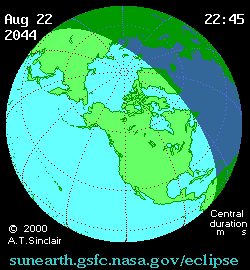
Animated path
Related eclipses
Solar eclipses of 2044–2047
This eclipse is a member of a semester series. An eclipse in a semester series of solar eclipses repeats approximately every 177 days and 4 hours (a semester) at alternating nodes of the Moon's orbit.[2]
| Solar eclipse series sets from 2044–2047 | ||||||
|---|---|---|---|---|---|---|
| Ascending node | Descending node | |||||
| 121 | February 28, 2044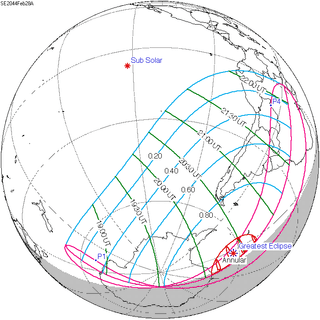 Annular |
126 | August 23, 2044 Total | |||
| 131 | February 16, 2045 Annular |
136 | August 12, 2045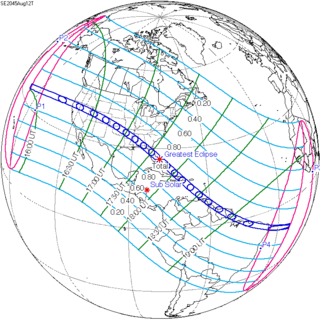 Total | |||
| 141 | February 5, 2046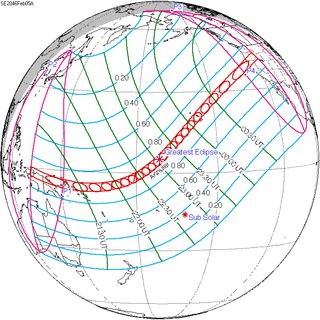 Annular |
146 | August 2, 2046 Total | |||
| 151 | January 26, 2047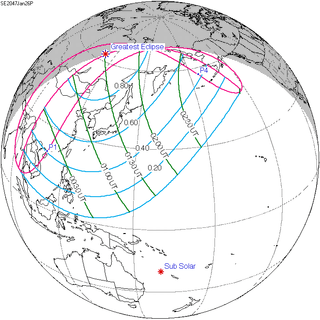 Partial |
156 | July 22, 2047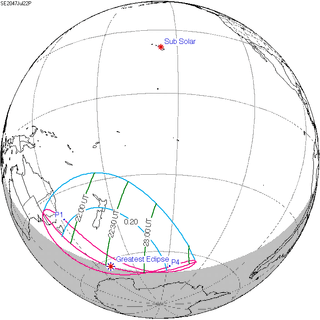 Partial | |||
| Partial solar eclipses on June 23, 2047 and December 16, 2047 occur on the next lunar year eclipse set. | ||||||
Saros 126
It is a part of Saros cycle 126, repeating every 18 years, 11 days, containing 72 events. The series started with partial solar eclipse on March 10, 1179. It contains annular eclipses from June 4, 1323 through April 4, 1810, hybrid eclipses from April 14, 1828 through May 6, 1864 and total eclipses from May 17, 1882 through August 23, 2044. The series ends at member 72 as a partial eclipse on May 3, 2459. The longest duration of central eclipse (annular or total) was 6 minutes, 30 seconds of annularity on June 26, 1359. The longest duration of totality was 2 minutes, 36 seconds on July 10, 1972. All eclipses in this series occurs at the Moon’s descending node.
| Series members 42–52 occur between 1901 and 2100 | ||
|---|---|---|
| 42 | 43 | 44 |
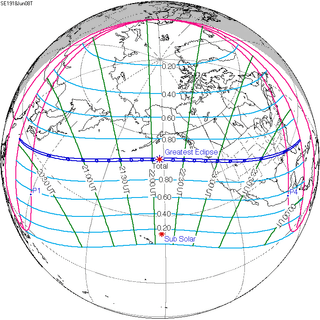 June 8, 1918 |
 June 19, 1936 |
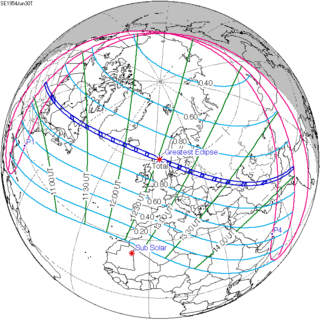 June 30, 1954 |
| 45 | 46 | 47 |
 July 10, 1972 |
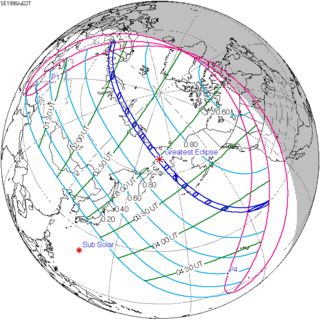 July 22, 1990 |
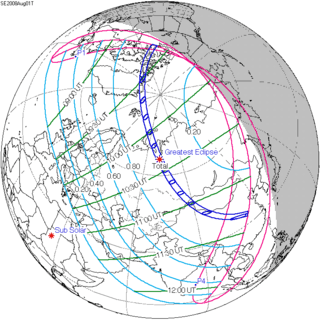 August 1, 2008 |
| 48 | 49 | 50 |
 August 12, 2026 |
 August 23, 2044 |
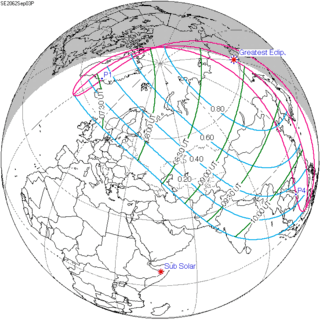 September 3, 2062 |
| 51 | 52 | |
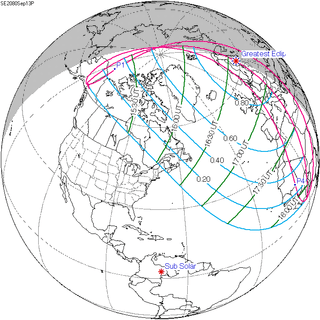 September 13, 2080 |
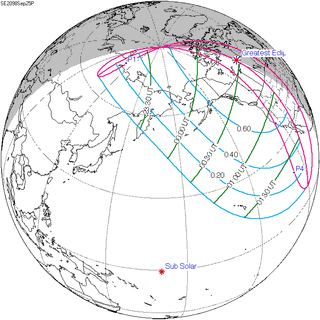 September 25, 2098 | |
Metonic cycle
The metonic series repeats eclipses every 19 years (6939.69 days), lasting about 5 cycles. Eclipses occur in nearly the same calendar date. In addition, the octon subseries repeats 1/5 of that or every 3.8 years (1387.94 days).
| 21 eclipse events between June 12, 2029 and June 12, 2105 | ||||
|---|---|---|---|---|
| June 11–12 | March 30–31 | January 16 | November 4–5 | August 23–24 |
| 118 | 120 | 122 | 124 | 126 |
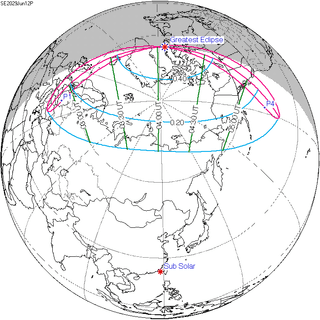 June 12, 2029 |
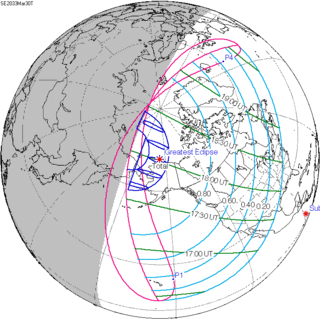 March 30, 2033 |
 January 16, 2037 |
 November 4, 2040 |
 August 23, 2044 |
| 128 | 130 | 132 | 134 | 136 |
 June 11, 2048 |
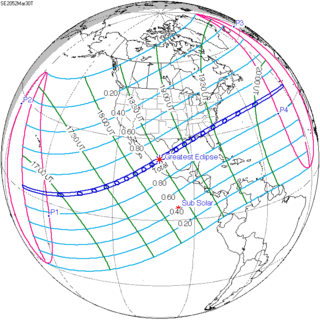 March 30, 2052 |
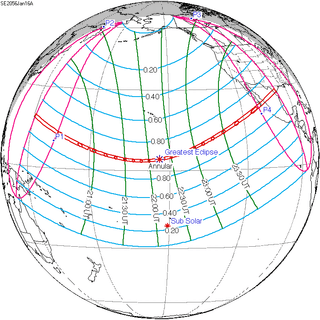 January 16, 2056 |
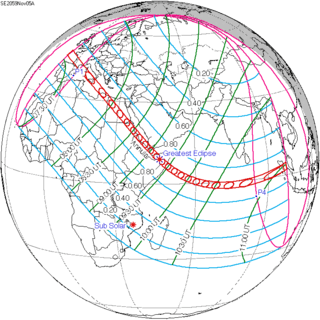 November 5, 2059 |
 August 24, 2063 |
| 138 | 140 | 142 | 144 | 146 |
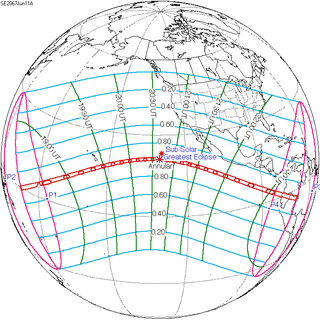 June 11, 2067 |
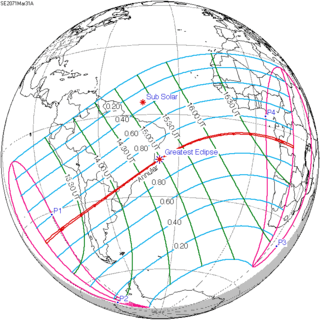 March 31, 2071 |
 January 16, 2075 |
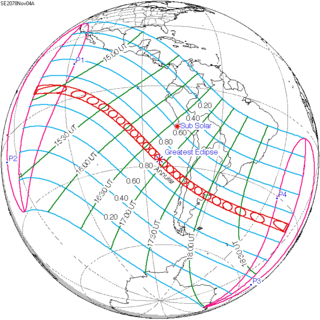 November 4, 2078 |
 August 24, 2082 |
| 148 | 150 | 152 | 154 | |
 June 11, 2086 |
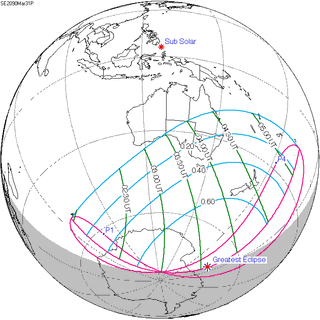 March 31, 2090 |
 January 16, 2094 |
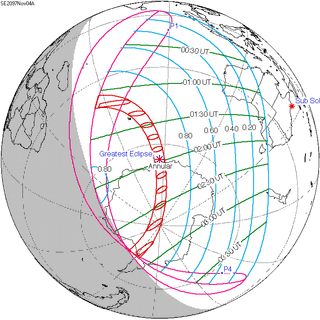 November 4, 2097 | |
References
- "Greatest Duration of Total Solar Eclipse of 2044 Aug 23". NASA Eclipse Website. NASA. Retrieved 9 September 2017.
- van Gent, R.H. "Solar- and Lunar-Eclipse Predictions from Antiquity to the Present". A Catalogue of Eclipse Cycles. Utrecht University. Retrieved 6 October 2018.
| Wikimedia Commons has media related to Solar eclipse of 2044 August 23. |
.jpg)
